Disclaimer: As an Amazon Associate I earn from qualifying purchases. Therefore, we may collect a share of sales from the links on this page, at no extra cost to you!
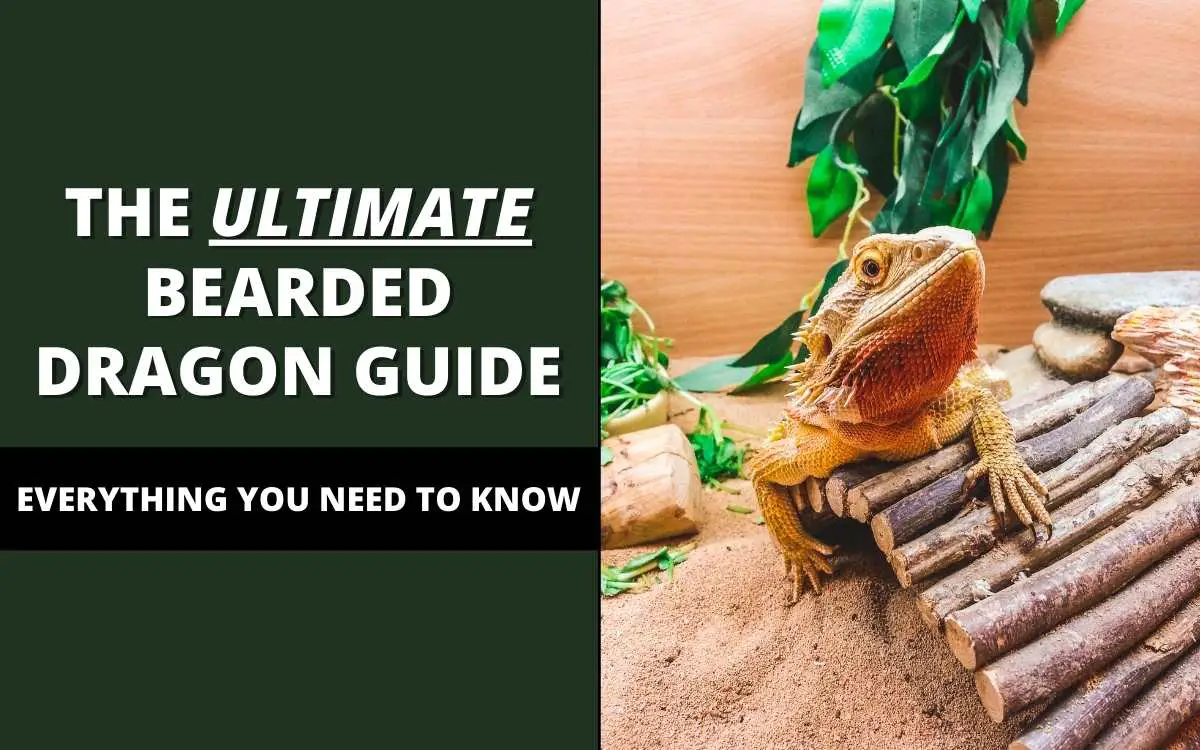
The Complete Bearded Dragon Care Guide
Bearded dragon care may seem like a complicated topic. And, to some degree–it is!
However, it’s not so much that bearded dragons are difficult to care for. Rather, there’s quite a few things you need to know before you purchase one.
This includes everything from where to buy a bearded dragon, lighting requirements, diet, tank size, shedding, medical care, and more. Having a solid understanding of these various topics will play an essential role in the health and happiness of your bearded dragon!
Therefore, within this bearded dragon care guide, we’re going to touch on all these points–in detail!
Keep in mind, this is going to be a long one! So, buckle your seat belts and let’s jump right in!
Jump to..
What is a Bearded Dragon?
A bearded dragon is a reptile that is part of the “Pogona” genus. The Pogona genus consists of eight different reptiles, all of which fall under the “bearded dragon” title. Each one of the different reptiles that fall under the Pogona genus is a little different from one another. But, generally speaking, they share the same basic physical traits.
Fun Facts About Bearded Dragons:
Bearded dragons are unique reptiles that possess a plethora of distinctive qualities that few other reptiles possess. The ten fun facts below are but a few of the many unique qualities that bearded dragons have to offer you!
10 Fun Facts
- To conserve water, while living in a dry environment, bearded dragons will excrete dry urine.
- A wild bearded dragon can go weeks without eating.
- A bearded dragon can last anywhere from three-days to two-weeks without water. The exact amount depends on the bearded dragon and the conditions that it is used to.
- The spines and bumps along a bearded dragon’s skin allow a bearded dragon to gather water. To drink this water, a bearded dragon will bow their head, allowing the collected water to flow onto their tongue and into their mouth.
- In the wild, the color of a bearded dragon is defined by the soil they were raised in.
- Unlike most lizards, if a bearded dragon’s tail is pulled off, it will never regenerate or grow back.
- A bearded dragon sees in color, just like us humans.
- The organ that bearded dragons rely on for smelling and tasting sits on the roof of their mouth.
- A bearded dragon’s front teeth will fall out and grow back as time passes.
- The side teeth in your bearded dragon’s mouth are, unlike the front teeth, completely permanent.
Appearance
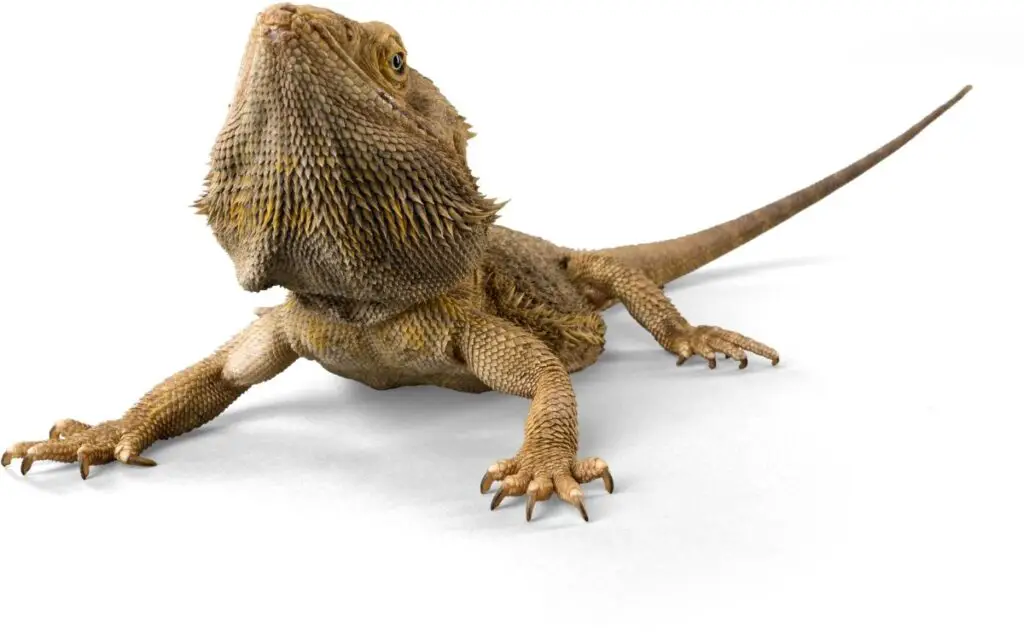
Recognizing a bearded dragon is quite easy, since every bearded dragon possesses two key aesthetic qualities that set them apart from other reptiles.
The first of these aesthetic elements is the thick, spiky collar that every bearded dragon has around its neck. A bearded dragon collar looks like a beard, which is why bearded dragons are known as “bearded dragons”.
The second aesthetic element every bearded dragon possesses is spiny scales. But, these scales aren’t just spiny; they’re covered in unique patterns and distinctive colors. No bearded dragon is the exact same when it comes to these patterns and distinctive colors.
Fun fact: Did you know that bearded dragons can be completely black due to a condition called melanism? If you want to see pictures of black bearded dragons, learn more about them, or see where you can buy one yourself, be sure to check out our Black Bearded Dragon Guide!
Male vs. Female Bearded Dragons
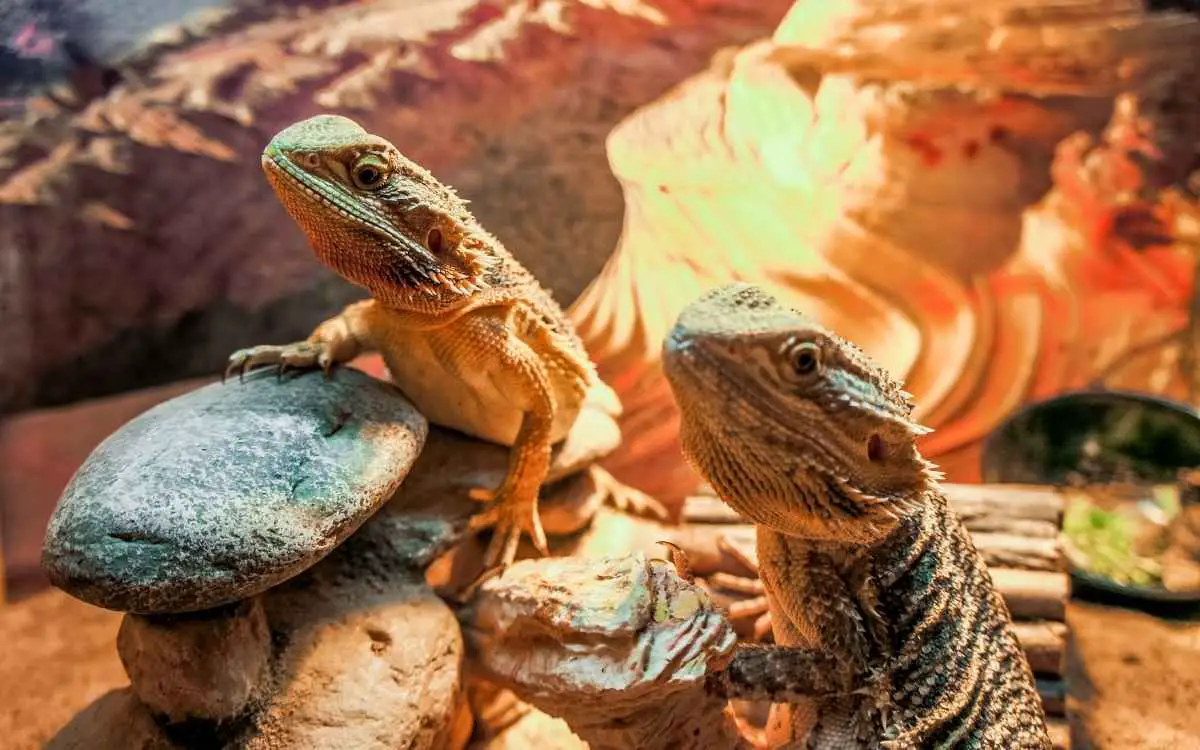
Male and female bearded dragons possess many of the same basic traits and characteristics. But, that being said, there are several notable differences that distinguish male and female bearded dragons from one another.
The most notable difference is the fact that male bearded dragons are extremely territorial, whereas female bearded dragons are not. Anytime a male bearded dragon feels his space is being infringed upon, he will react in an aggressive manner. A female bearded dragon, however, will often submit, rather than attempt to fight back.
Physically, male and female bearded dragons differ from one another in two key ways. The most notable difference is size, since male bearded dragons are larger and wider than female bearded dragons. Along with that, male bearded dragons have two bumps on the underside of their tail, whereas female bearded dragons have just one bump in the center of their tails’ underside.
In addition, male bearded dragons typically have darker beards than female bearded dragons. This is because a dark beard will make a male more attractive in the eyes of a female bearded dragon. In addition to darkening their beards, male bearded dragons will also bob their heads as a way to attract females.
More: Check out our article on sexing your bearded dragon!
Why Should You Get A Bearded Dragon?
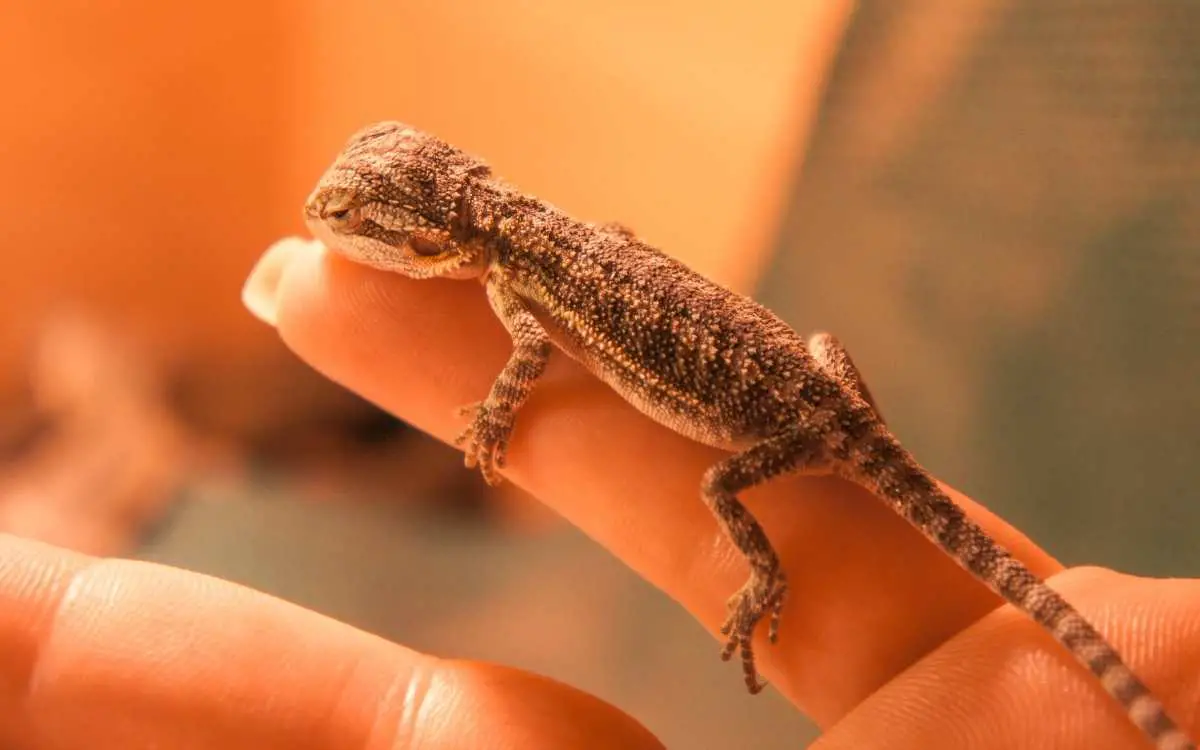
Admittedly, the average reptile is rather difficult to raise and care for. But, bearded dragons are not your “average reptile” and, instead, are some of the easiest pets to raise and take care of.
The reason for this ease is that bearded dragons are simple reptiles with simple needs. So long as you feed your bearded dragon regularly, make sure that they have enough water, keep the temperature in their habitat just right, and bathe them on a regular basis, they will be comfortable and happy.
For a simple reptile that won’t take too much time or energy to care for, bearded dragons are perfect. But, that is just one of the many desirable qualities that bearded dragons offer pet owners.
More Desirable Qualities
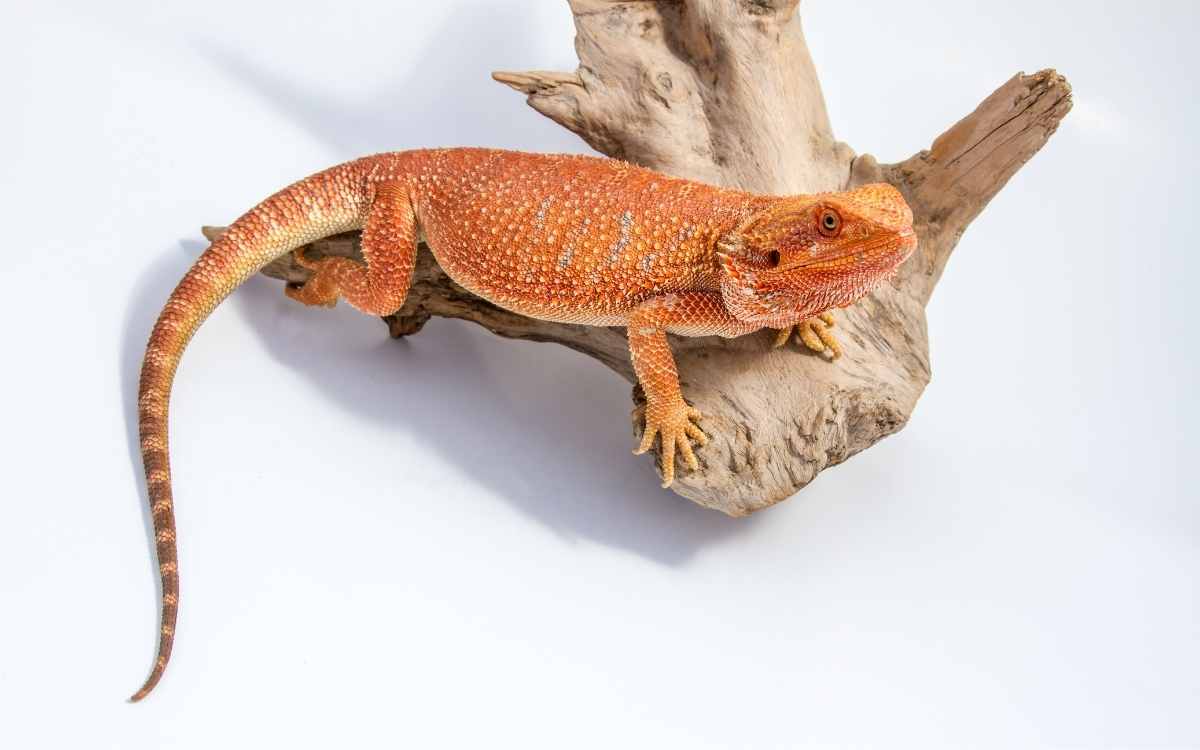
Every bearded dragon possesses its own unique colors and patterns. Looking at a bearded dragon and paying attention to these unique elements is a ton of fun!
Most bearded dragons are very cute.
Unlike some other reptiles, bearded dragon’s don’t take up that much space. You won’t need to set aside too much space for your bearded dragon, which makes them great for smaller houses and apartments.
On average, a bearded dragon will live anywhere from four-years to twelve-years. The exact age is, of course, dependent on factors such as health and genetics. But, that length of time is long enough to bond and connect with a bearded dragon, while being short enough to the point where taking care of your bearded dragon is not a lifelong task.
Another amazing quality that bearded dragons posses are their laid back personalities. They are quite passive and enjoy being handled and taken out of their enclosures regularly.
Unlike other lizards, bearded dragons are safe to take care of and will rarely bite or attack. But, even if they do, the damage is minimal. To learn the reasons why bearded dragons bite – or see pictures of what you can expect from a bite, see our guide: Do Bearded Dragons Bite & Does it Hurt? (don’t worry, there are no graphic photos).
What Does it Cost to Care for a Bearded Dragon?
Initially, caring for a bearded dragon can be rather expensive. But, as time passes, and as you acquire everything that you need to adequately care for your bearded dragon, the costs will go down significantly.
Here are some of the upfront costs when buying a beaded dragon:
A Good Habitat
For many bearded dragon owners, the biggest – and most important – investment, aside from the bearded dragon itself, is a good habitat. The value of a good habitat cannot be overstated, since your bearded dragon will be spending most of their time in this habitat and, as such, needs to feel safe and comfortable.
A good habitat, for a fully-grown bearded dragon, is an aquarium that is meant to hold seventy-five-gallons of water. You can purchase an aquarium of this sort for anywhere from $100 to $750. The exact price will depend on the quality of the aquarium, whether it has been used or not, and the materials that it uses.
No matter the aquarium that you purchase, make sure it uses either glass or plexiglass for the windows, and comes with a mesh lid. Both of these features are essential for the comfort of your bearded dragon, since they allow light to enter the aquarium with ease.
Accessories for the Habitat
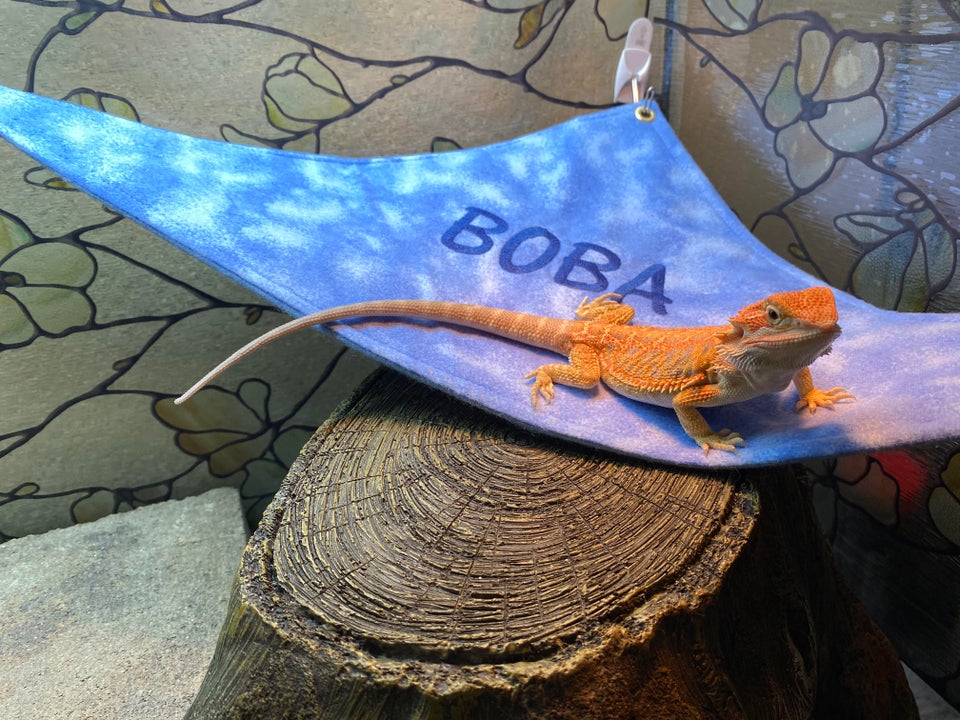
Every habitat needs high-quality flooring, a thermometer, a hygrometer, dishes for food and water, a basking rock or hammock, and systems for heating and lighting.
All of those components will, when added up, cost anywhere from $100 to $250. The exact price will depend on what it is that you purchase and what those specific items offer.
More often than not, the flooring, food/water dishes, and basking spot will, when purchased together, cost around $50. Once you add the thermometer, hygrometer, UVA bulb, UVB bulb, and lamp, though, the price goes up quite a bit.
Even though these accessories can be expensive, purchasing an accessory that’s cheaper, but lower-quality, is not a good idea. Low-quality accessories will fall apart more quickly and, when it comes to bulbs, thermometers, and hygrometers, they may not function properly.
Pro Tip: We recommend getting 1-2 hammocks for your bearded dragons enclosure. One hammock will be for the cool side and the other will be for the hot side. Click here to check out our 10 favorite bearded dragon hammocks.
Healthy Foods
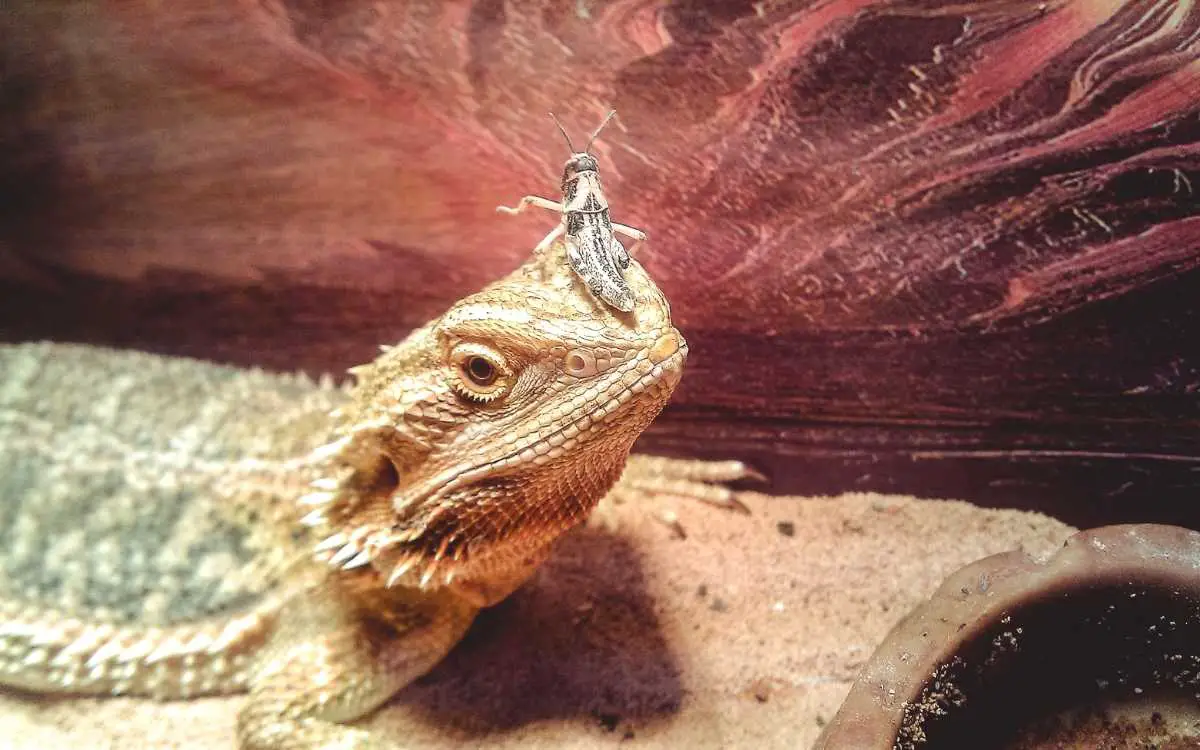
A healthy diet, for a bearded dragon, consists primarily live insects – crickets and mealworms, for example – and vegetables. Purchasing insects and vegetables regularly will cost you around $20 per-week, depending on how much you buy and where you buy them from.
To make the process of feeding your bearded dragon a lot easier, you can invest in a “keeper”. A keeper is, essentially, a special cage that is meant to hold insects. You can keep all of the insects that you purchase inside this cage, keeping them alive until it’s time to feed.
For a good keeper, you will end up spending around $40. The exact price will, of course, depend on the keeper that you purchase. A good keeper will last for many years, though, while also making the entire process of feeding your bearded dragon a lot easier.
Purchasing vitamins and supplements for your bearded dragon, and feeding them to your bearded dragon during meals, will keep them nice and healthy. You don’t have to purchase vitamins and supplements, but doing so is recommended, and will only cost you around $10 per-month.
Proper Medical Care
Proper medical care, as any pet owner knows, can be ridiculously expensive. Fortunately, though, these high-costs may never come into play, as long as you take good care of your bearded dragon.
Even if you take great care of your bearded dragon, though, accidents do happen and you may have to take your bearded dragon to the vet. Depending on what happened, and what’s needed, you may end up spending anywhere from $20 to thousands-of-dollars. The exact cost will depend on the specifics of your situation, including whether or not you have insurance for your bearded dragon.
Some of the best health insurance packages, for bearded dragons, are less-than-ten-dollars per-month. For many bearded dragon owners, these packages are a great investment and they can alleviate any potential worry or stress. If you purchase a bearded dragon that you know is prone to health issues, then a good, but affordable, bearded dragon health insurance package is absolutely essential.
Where Can You Get a Bearded Dragon?
You can get a bearded dragon from your local pet store, a bearded dragon breeder, a reptile rescue organization, or an online marketplace such as Craigslist or Facebook. Each one of those options is excellent but, depending on what you are looking for, one option, in particular, may be a better choice than the others.
Getting a Bearded Dragon from a Pet Store
For many, getting a bearded dragon from a local pet store seems like an obvious choice. Most pet stores have quite a few bearded dragons to choose from, while also being able to sell you everything that you need to properly raise and care for your bearded dragon.
Even though both of those things are true, to some extent, getting a bearded dragon from your local pet store isn’t always a good idea.
Most pet stores will, at any given time, hold a variety of different bearded dragons together. More often than not, these conditions are unsanitary, which means that the bearded dragons being sold might pick up viruses and diseases from one another.
To go along with that, the staff at your local pet store may not be equipped to offer you the best information, when it comes to raising and caring for your new bearded dragon. As a result of this, you may have a more difficult time raising and caring for your bearded dragon, due to being given information that isn’t particularly useful or suitable.
Hence, many reptile experts advise against getting a bearded dragon from a pet store. Rather, they recommend getting a bearded dragon from a reputable breeder or reptile expo (if they’re in your area).
To add on to this point, pet stores almost never carry any special bearded dragon morphs such as snow (white), tangerine (orange), citrus (yellow), or fire (red). Instead, they usually only carry the “normal” variation which is brown or grey in color.
Getting A Bearded Dragon from a Breeder
These days, there is a stigma surrounding professional breeders and their practices. Despite this being the case, though, getting a bearded dragon from a breeder is still one of the easiest and safest ways to acquire a bearded dragon.
To find the right breeder, it’s important to consider the type of bearded dragon you want. Take some time to think about the colors and patterns you are looking for. Chances are, if there’s a specific appearance or aesthetic that you are looking for, a professional breeder will offer it.
Once you are familiar with the bearded dragon you are looking for, it’s time to do some research. Finding the right breeder can be very easy, if you go onto Google and search for professional bearded dragon breeders that reside within your state. Doing so will give you plenty of breeders that may, or may not, offer what you are looking for.
As an alternative, you can join local reptile groups on Facebook. Many professional breeders are in these groups and can contact you from within the group. You can also ask the members of the group about a professional breeder that can meet your needs and, chances are, you will receive plenty of excellent recommendations.
There are also plenty of bearded dragon breeders that solely sell their reptiles online. Some of the biggest names include CB Reptiles, XYZ Reptiles, and LLL Reptiles. Each of these breeders has an incredible selection and has been selling bearded dragons online for many years.
Learn More: Interested in buying a bearded dragon from an online breeder? See our list of the 10 most reputable bearded dragon breeders in the USA!
Anytime you find a breeder that looks good, make sure to dig a little deeper and look for reviews and testimonials. Reviews and testimonials will give you a good idea as to what a particular breeder offers and whether they offer what you are looking for.
When you speak with a breeder that you’re thinking about purchasing from, make sure to ask questions. Don’t be afraid to be thorough, either, since you will want to know if the breeder you are speaking with is honest about what they offer and how they are breeding their bearded dragons.
Getting a Bearded Dragon from a Reptile Rescue Organization
Many of the bearded dragons you will find at a reptile rescue organization come from homes where they were mistreated or abused. Since this is the case, asking about the temperament of a bearded dragon and spending some time with the bearded dragon, if possible, is recommended before every adoption.
The majority of reptile rescue organizations perform very thorough medical check-ups before every adoption. You will not have to worry about problems of that sort, if you adopt from a reptile rescue organization. But, depending on the medical check-up and the organization itself, you may have to pay a fee before you can adopt a bearded dragon.
Some reptile rescue organizations are more thorough, when it comes to vetting adopters, than others. Depending on the reptile rescue organization you adopt from, you may need to prove to the organization that you can adequately care for a bearded dragon. Other organizations may also make you sign an agreement that prevents you from selling the bearded dragon.
Getting a Bearded Dragon from Facebook & Craigslist
Facebook and Craigslist are two of the best online marketplaces you can use to acquire a bearded dragon. Both marketplaces can be narrowed down to your local area, making it a lot easier to find a bearded dragon you can drive to pick up. Along with that, Facebook and Craigslist both receive a massive number of “For Sale” posts every day, which gives you plenty of choices.
If you live in a less-populated city and there’s no bearded dragons available at the moment of your search, Craigslist actually has a feature that enables you to save a search to get notified when the item you’re looking for is up for sale.
In order to do this, you’ll need to sign up for Craigslist. From there, enter the search term you’re looking for. In this case, it will be “bearded dragon”. Once you click to search it, a option will appear on the right of your search bar that says “Save Search”.
Click this option and you will be notified every time someone posts a bearded dragon for sale!
Here’s a screenshot of what the “Save Search” feature looks like:
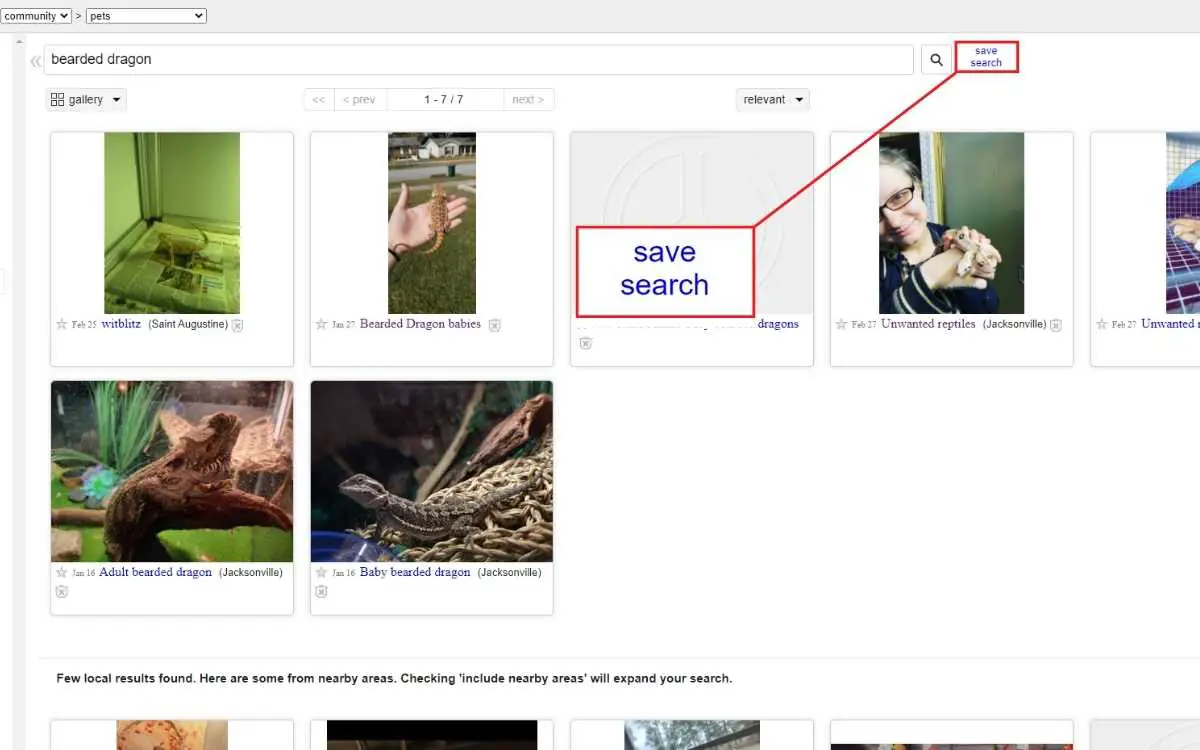
Since Facebook and Craigslist are both relatively anonymous, though, you must be cautious. There are plenty of horror stories out there, so it’s important that you speak with the seller before purchasing and that you go with your gut if something seems off.
Ideal Environment for a Bearded Dragon
As mentioned earlier in this guide, bearded dragons are from the Pogona genus. The Pogona genus comes from the subtropical woodlands, savannas, and deserts within Australia. All of these environments are known for being arid and dry.
Since bearded dragons come from arid and dry environments, they are meant for environments of that sort. Your bearded dragon must have a warm and dry place to call home. Too much cool air, or too much humidity, can easily lead to your bearded dragon being uncomfortable and, as a result, suffering from various health issues.
Fortunately, setting up a warm and dry environment, for your bearded dragon, is easy. You only need to find a few thing and, once you set them up, your bearded dragon will have a cozy and comfortable place to call home.
Tank Requirements
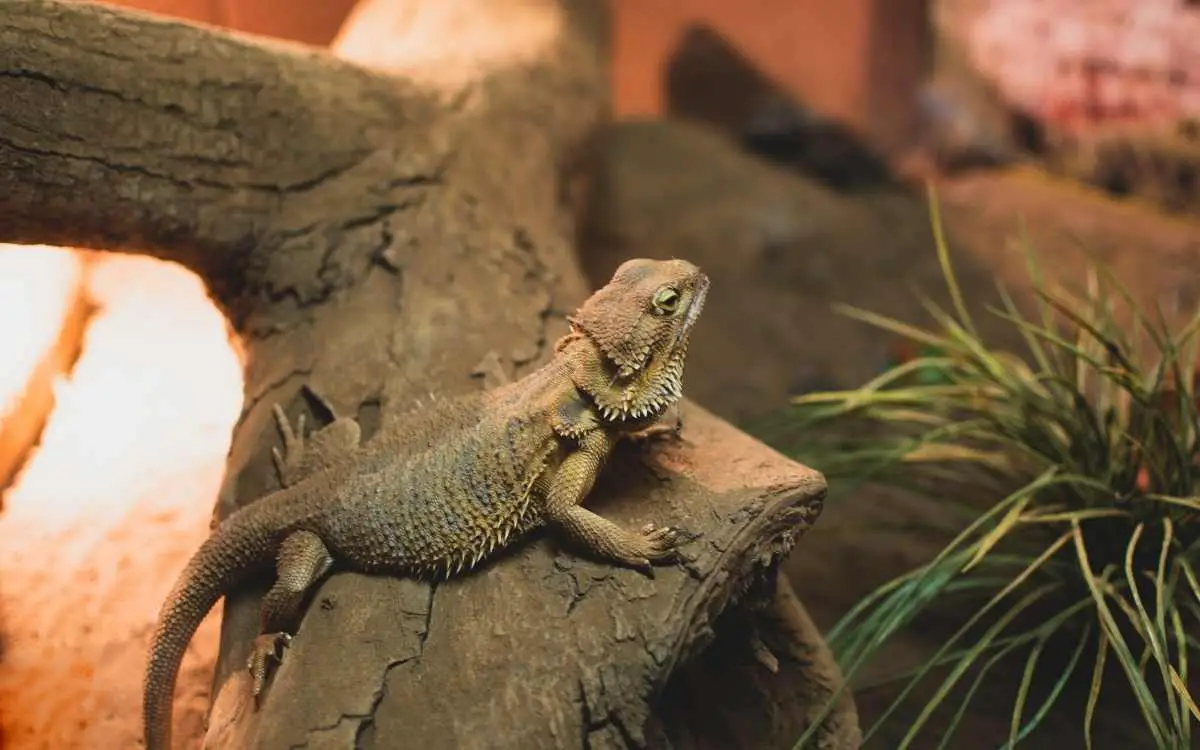
Every pet store will offer a plethora of different reptile habitats. Many of these are quite nice, but there’s one habitat, in particular, that you should look for: a large aquarium with a mesh lid.
A large aquarium, with a mesh lid and glass windows, is quite inexpensive. You won’t have to spend a lot of money to acquire a habitat of this sort.
While searching for the right tank, there are three important traits to look for and consider. The first of these traits is size, the second is the design of the mesh lid, and the third is the material that the aquarium windows are made of.
For the aquarium’s size, you will need to purchase an aquarium that holds, at the very least, seventy-five-gallons of water. A grown bearded dragon needs a lot of space to wander around, hide, sleep, eat, and relax.
Even though an adult bearded dragon needs a large aquarium, that doesn’t mean smaller bearded dragons require them, too. Rather, younger bearded dragons can live in twenty-five-gallon aquariums and fifty-gallon aquariums. All of this is dependent on age, however, and due to the steps that go into setting up an aquarium, combined with the overall cost, it is often recommended that you purchase a large aquarium, even if your bearded dragon is young, so that you don’t have to upgrade later on.
For the design of the mesh lid, make sure it can be taken on and off with ease. More importantly, though, make sure the mesh lid allows light to flow into the aquarium.
The aquariums should be made of either glass or plexiglass. Both materials are durable and reliable, while also allowing light to flow into the aquarium.
How Big do Bearded Dragons Get?
A fully-grown bearded dragon requires an aquarium that is, at the very least, capable of holding seventy-five-gallons of water. A smaller bearded dragon requires less than that but, as the bearded dragon gets older, they will require a larger space.
All of this begs a question: how large are bearded dragons?
A fully-grown bearded dragon will be anywhere from sixteen-inches to twenty-four-inches in length. As for weight, a fully-grown bearded dragon tends to weigh anywhere from 380 grams to 510 grams.
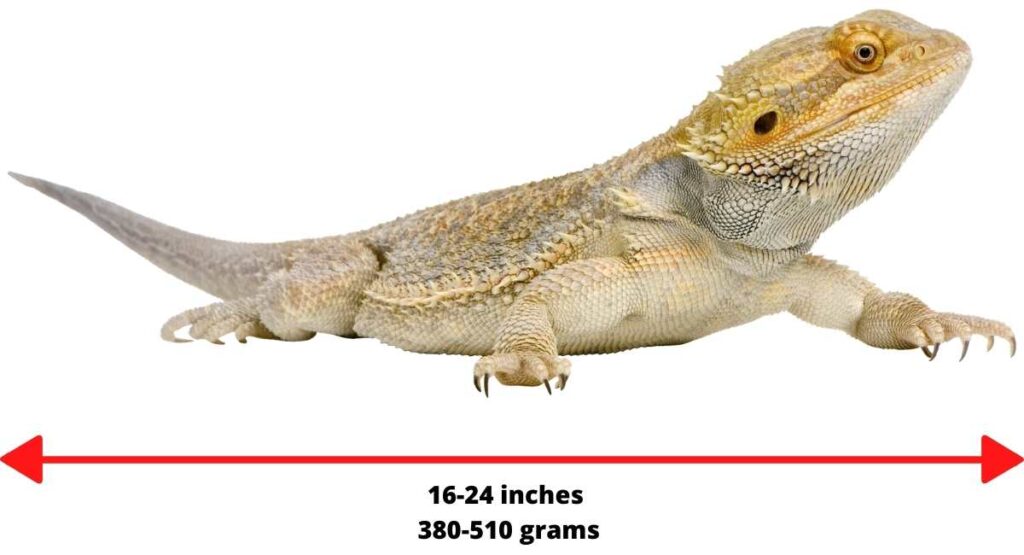
Due to the length and weight of the average bearded dragon, a big aquarium is necessary. Small aquariums can result in your bearded dragon feeling cramped and uncomfortable. Both of these can lead to health issues.
The exact length and weight of your bearded dragon is heavily dependent on nutrition, habitat, and genetics. To ensure that your bearded dragon grows up healthy and strong, the best thing you can do is feed them the right food, while also giving them a comfortable habitat to reside in.
Your bearded dragon will stop growing after they reach sexual maturity. The exact age a bearded dragon reaches sexual maturity is different for every bearded dragon. But, as a general rule, it is usually anywhere from eight-months of age to eighteen-months of age.
Best Substrate for Bearded Dragons
Many reptiles live in habitats that are filled with sand, wood chips, and pebbles. For many reptiles, these materials are fine. For bearded dragons, however, they often pose a danger, since bearded dragons may accidentally swallow those materials and hurt their digestive tract.
Rather than purchasing sand, wood chips, or pebbles – among other soil materials – you should purchase reptile carpet. Reptile carpet is a soft, flat, and non-abrasive material. Your bearded dragon will always be comfortable while walking or laying on the material, and there is no risk of them ingesting the material that comprises reptile carpet.
Just as a general recommendation, you should purchase two sheets of reptile carpet, rather than just one. Reptile carpet can get dirty rather easily, and you will want your bearded dragon to have a soft surface to walk and lay on, while you’re cleaning the dirty reptile carpet.
Lighting & Heating
UVB & UVA Lighting Requirements
The most important feature of every bearded dragon habitat is the lighting and heating system that is used. A good lighting and heating system is invaluable, while a bad lighting and heating system can affect your bearded dragon’s health in a plethora of negative and unfortunate ways.
Every bearded dragon relies on two types of light. These two types of light are UVA light and UVB light. UVA light is visible light and, as such, defines the day/night cycle the bearded dragons live by, while also generating heat. UVB light is invisible light that provides your bearded dragon with large quantities of Vitamin D3, and Vitamin D3 allows bearded dragons to absorb calcium.
For smaller bearded dragons, a full-spectrum lamp is recommended. More often than not, these full-spectrum lamps are smaller, so they work well for young bearded dragons.
For older, and bigger, bearded dragons, purchasing both a UVA lamp and a UVB lamp is recommended. You can set these lamps up anywhere along the top of a large aquarium, giving you plenty of flexibility when it comes to where the lamps are and where they are shining.
The UVA lamp and the UVB lamp should be on for at least twelve-hours throughout the day, and no more than fourteen-hours. That way, the lights don’t disrupt your bearded dragon’s natural cycles.
Heating Requirements
Every bearded dragon needs two spaces in its habitat: a warm space, with a high temperature, and a cool space, with a lower temperature. The warm space should be anywhere from 95-degrees Fahrenheit, to 110-degrees Fahrenheit, while the cool space should be no higher than 85-degrees Fahrenheit.
To develop a cool and a warm space, you will need to set up the UVA and UVB lamps in a way that allows for those two spaces to be delineated. But, along with that, you will need to set-up a basking lamp so that your bearded dragon has a small, but significant space to warm up. Setting up a basking lamp is very easy, and you can buy one at your local pet store, or use an unfrosted household bulb that offers a high-wattage.
For houses that go below 65-degrees Fahrenheit, you must purchase a heating device. A ceramic heating emitter works very well, and keeps the temperature nice and warm. To ensure that the temperature is ideal, at all times, a digital thermometer is a wise investment.
For houses with humid air, you must use a dehumidifier to remove the excess humidity. Make sure to keep the humidity levels anywhere from 20% to 40%.
Many dehumidifiers come with a built-in humidity gauge. Due to the placement of this dehumidifier – often a foot-or-two away from the aquarium – a humidity gauge is recommended, since it will provide the most accurate humidity reading. That way, you will know what the current humidity levels are, and whether you should turn on the dehumidifier.
Water Bowls & Food Dishes
To keep your bearded dragon healthy and happy, you will need to purchase a water bowl and a food dish.
The water bowl that you purchase for your bearded dragon should be shallow and low-to-the-ground. Some bearded dragons don’t enjoy drinking water, to remedy this, you can purchase a larger water bowl that they can enter. Entering a water dish of that sort, and swimming in it, will allow your bearded dragon to absorb the water using their natural water-absorption abilities.
The food dish that you purchase should be shallow and low-to-the-ground. Along with that, the edge should be high enough that bits of food won’t fall onto the reptile carpet. Make sure the edge isn’t too high, though, so that your bearded dragon won’t have to strain themselves to eat their food.
A Basking Accessory
For most of the day, your bearded dragon will spend their time basking underneath the basking lamp. To give your bearded dragon the best basking experience possible, you will need to purchase a good basking accessory.
Just about every bearded dragon loves a good hidey-hole. Most pet stores offer rocks or hammocks that are meant for basking. These accessories often come with small openings that lead to an enclosure. These are very affordable basking accessories that almost every bearded dragon loves.
To find the right basking rock or hammock, think about the size of your bearded dragon and, as a result, the size of the accessory. Make sure to find a rock or hammock that your bearded dragon can lay on top of comfortably. Most importantly, make sure your bearded dragon will have no problems entering and exiting it.
All of those qualities make for a fantastic basking accessory. Your bearded dragon will have a very pleasant time basking throughout the day!
How Can You Find the Right Bearded Dragon?
Finding the right bearded dragon is easy. There are just a few qualities that you need to look for. Once you find a bearded dragon with these qualities, you’ll have found the bearded dragon that’s right for you.
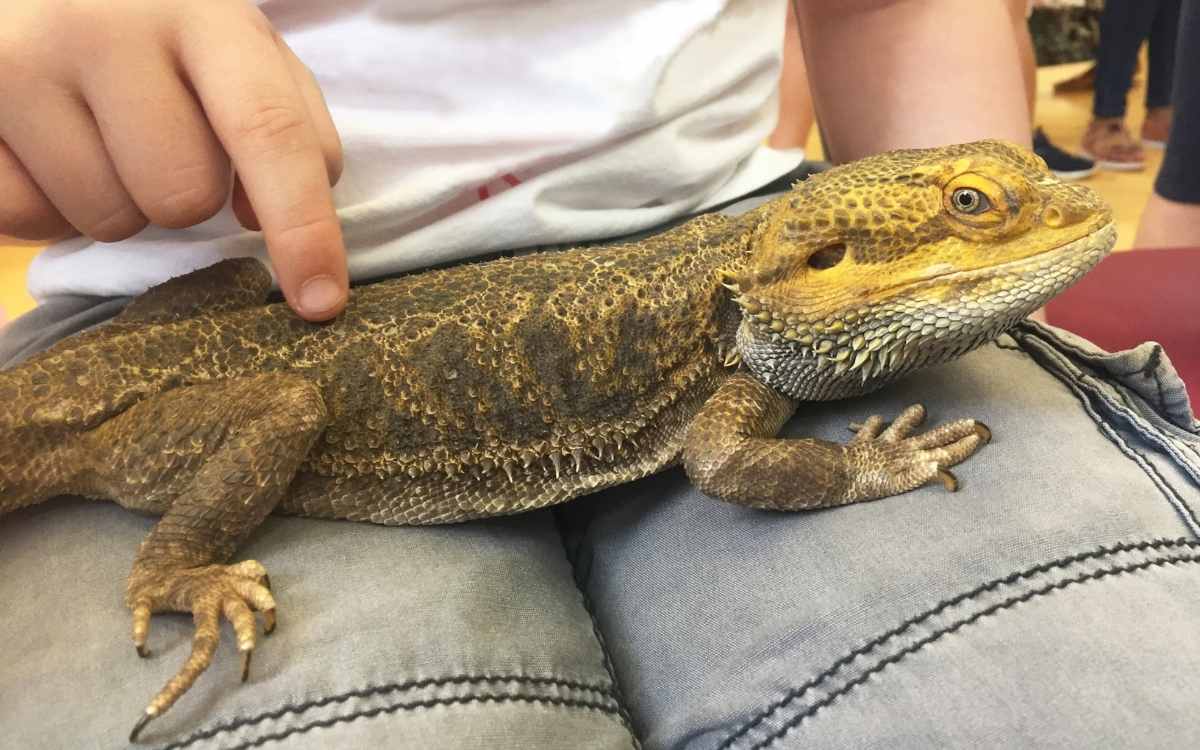
A Good Connection
The most important element to consider, when looking for a bearded dragon or any other pet, is the sense of connection you feel with a particular bearded dragon.
More often than not, this sense of connection is intuitive, rather than rational. You may first experience it as you look at different bearded dragons. One of those bearded dragons may stand out to you and, if a particular bearded dragon does, then that’s a great sign.
To make sure that the bearded dragon reciprocates that, you should ask to pick up and hold the bearded dragon that interests you. Pay attention to how the bearded dragon reacts. Make sure the bearded dragon is friendly, interested, and, at the very least, somewhat comfortable.
Good Health
Even if the bearded dragon you are looking at has a great connection with you, there’s one more thing you need to consider: health. More specifically, you need to make sure the bearded dragon you adopt is healthy. To do this, there are several key traits and qualities to look for.
The first of these qualities is making sure your bearded dragon is at least four-inches long. A bearded dragon that is shorter than four-inches is, as a general rule, too young to be adopted.
Right after you take a look at the bearded dragon’s length, pay attention and look for scars, bumps, or missing limbs. Make sure to ask about those, if you notice them, so that you know what happened and what you need to do to take care of your new bearded dragon. A bearded dragon that is dealing with serious injuries may be difficult to care for, so keep that in mind.
The next quality to consider is the bearded dragon’s movement. Take a look and see whether the bearded dragon is moving in a smooth and agile manner, or with trembling and jerkiness. If it’s the latter, then that’s a sign the bearded dragon may be uncomfortable or dealing with a health problem that you need to be aware of.
Finally, the last quality to consider is the bearded dragons demeanor. A healthy bearded dragon will be relatively friendly and content. An unhealthy bearded dragon, on the other hand, will look upset and angry, while acting in a manner that reflects those feelings. Caring for a mean and unhappy bearded dragon is a big challenge and, while it’s certainly possible to do so successfully, it may not be a task you’re up for.
What Should You Feed a Bearded Dragon?
A healthy bearded dragon relies on a steady diet filled with protein, fruits, and vegetables. To keep your bearded dragon extra healthy, a supplement or two goes along very well with the other foods that healthy bearded dragons rely on.
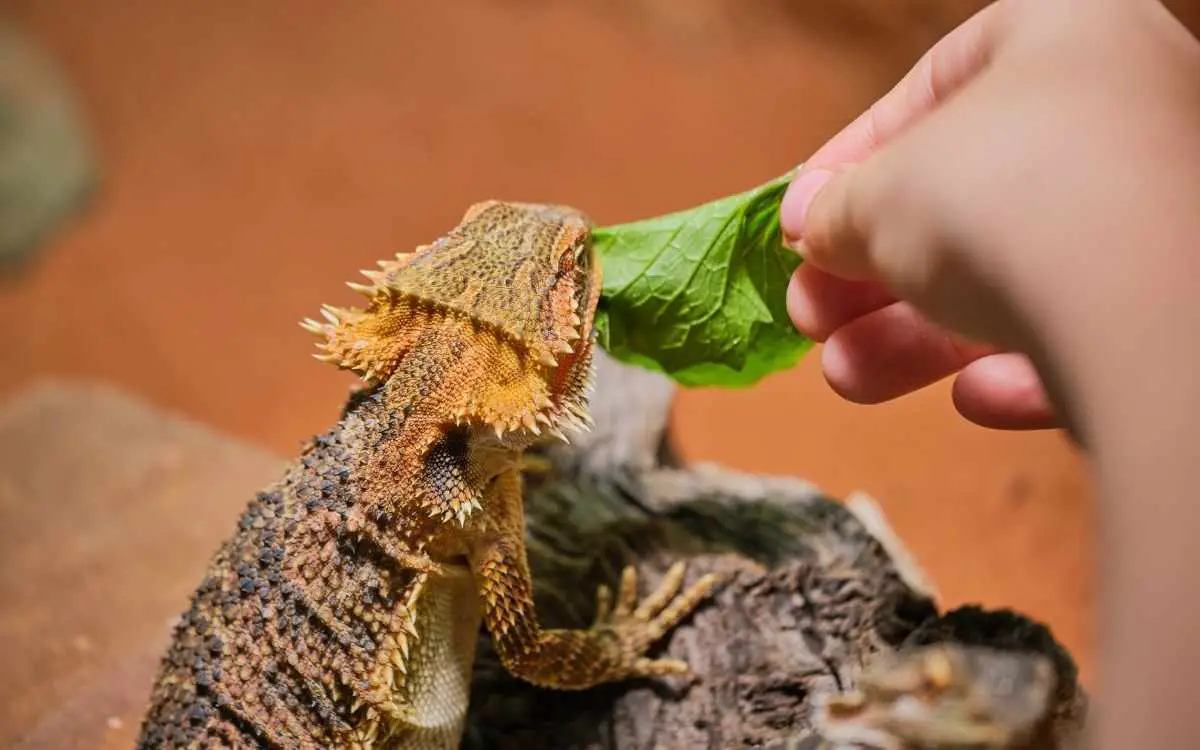
Protein
Protein is one of the most essential nutrients in every bearded dragons diet. A healthy bearded dragon will often eat crickets and mealworms, both of which are an excellent source of high-quality protein.
For your bearded dragon’s daily dose of protein, live crickets are inexpensive, easy to acquire, and rich with protein. You should feed your bearded dragon live crickets on a daily basis.
Mealworms, on the other hand, are just as protein-rich, but should be given less frequently. Every mealworm is covered with a relatively hard shell, which is a great source of fat and calcium. But, due to the large amount of fat and calcium within mealworms, they’re better served as treats, rather than as a staple of every meal.
Fruits
Just about every bearded dragon loves fruit. Most fruits lack nutrients, and are filled with sugar, so they’re better served as a small part of a larger meal, rather than as the main dish of a meal. You can even mix them up with crickets and vegetables, so that your bearded dragon is more tempted to eat the meal you’re serving them.
Some of the best fruits to feed your bearded dragon are as follows: watermelon, tomatoes, strawberries, blackberries, blueberries, tomatoes, grapes, melons, peaches, apricots, figs, and dates.
Mushrooms, avocados, and citrus fruits are terrible for bearded dragons. Avocados and mushrooms are both poisonous to bearded dragons. Citrus fruits are incredibly acidic and, as a result, can lead to issues with digestion.
Vegetables
Every bearded dragon is a little different, when it comes to the vegetables it enjoys eating. As a result of this, during the first two-or-three-weeks of caring for your new bearded dragon, feel free to give them a variety of different vegetables. By doing so, you will be able to figure out the vegetables your bearded dragon enjoys eating, and the vegetables that they do not enjoy eating.
As a general rule, most bearded dragons enjoy dark, leafy greens – kale being one example – as well as red and orange vegetables – bell peppers and carrots being two examples. You can feed your bearded dragon these vegetables every day and they’ll be as healthy as they can be.
Lettuce and celery are both rich in fiber and filled with water. Despite this being the case, though, they lack other nutrients and, as a result, you shouldn’t feed them to your bearded dragon. To go along with that, they have been shown to create digestion issues.
Supplements
A diet filled with good sources of protein, high-quality vegetables, and tasty fruits is more than enough for your bearded dragon.
All of that being said, though, supplements can still be very useful. Some bearded dragons refuse to eat certain foods, and others may not be getting all of the nutrients that they need, despite eating their meals.
The two most notable supplements to give your bearded dragon are as follows: a calcium supplement, and a Vitamin D3 supplement. A lack of calcium can lead to a plethora of unfortunate health problems, and a lack of Vitamin D3 can lead to those same issues, as well as a variety of others.
You will find calcium supplements and Vitamin D3 supplements that contain Vitamin A. Vitamin A is, when ingested in excessively large amounts, quite toxic to bearded dragons. Make sure the supplements you purchase do not contain Vitamin A but, rather, Beta-Carotene. Beta-Carotene supplies the exact amount of Vitamin A your bearded dragon needs, and no more than that.
Learn More: Check out our article on my favorite calcium supplements and the most effective ways of administering calcium.
Water
Just like every other reptile, bearded dragons rely on water to stay alive and healthy. To keep your bearded dragon healthy, the best thing you can do is purchase a water dish and fill that dish up with fresh water whenever it is empty. Doing so gives your bearded dragon easy access to water whenever they get thirsty.
Every now and then, your bearded dragon may be reluctant to drink from its water dish. When this happens, the best thing you can do is fill a spray bottle with water and then spray some of that water onto your bearded dragon. Your bearded dragon can then drink the water directly from their body, while also being able to absorb the water that you’ve sprayed.
How Can You Take Care of a Bearded Dragon?
Taking care of your bearded dragon can be quite daunting. Proper care requires you to consider a number of different things, such as a daily feeding and cleaning routine. But, if you know what to do, and how to do it, then the entire process of caring for your bearded dragon is much easier.
Connecting With Your Bearded Dragon
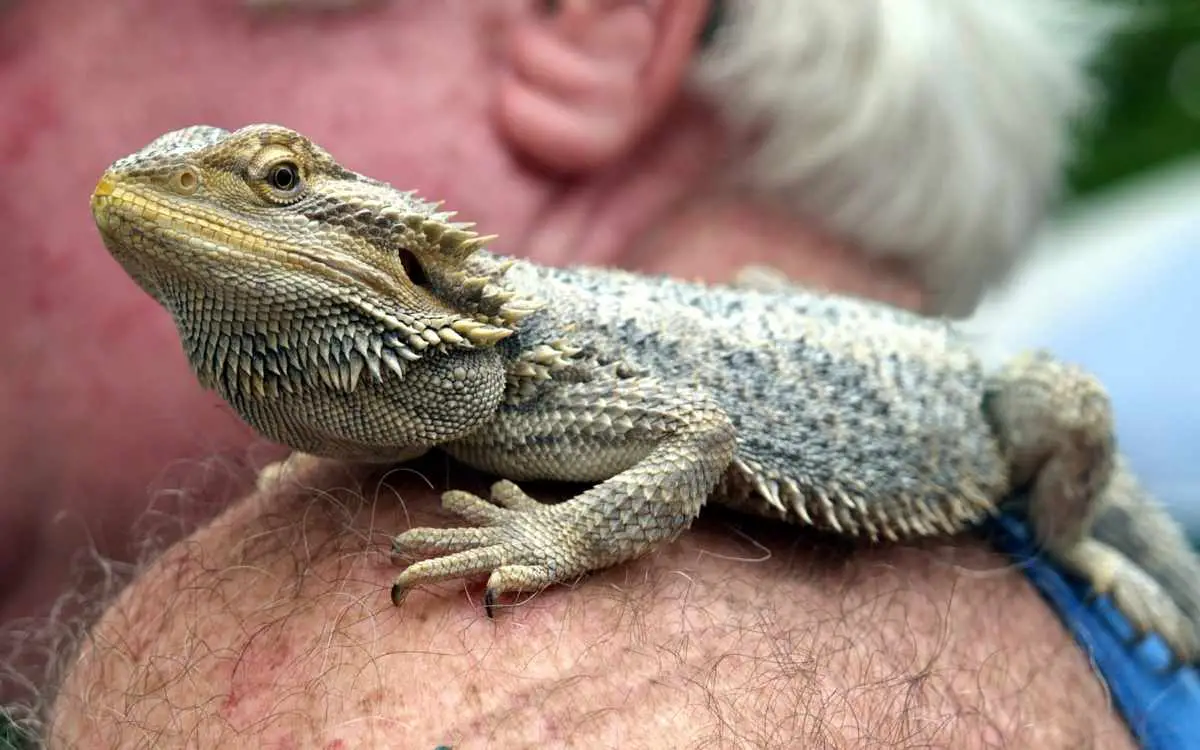
Bearded dragons are solitary reptiles that enjoy being alone. Even though this is the case, though, taking some time to bond with your bearded dragon will make them healthier, and allow you to connect with your bearded dragon on a deeper level.
To connect with your bearded dragon, you need to know how to properly handle your bearded dragon. Proper handling is rooted in knowing how to pick up your bearded dragon in a way that ensures they are completely comfortable and at peace.
The easiest way to pick up your bearded dragon involves showing the bearded dragon your hands, and then moving those hands slowly underneath its belly. Right after your hands are underneath your bearded dragon’s belly, you can pick up your bearded dragon. Make sure to do this slowly, while also keeping the tails and limbs completely supported.
After you pick up your bearded dragon, feel free to let them explore and hang out with you. Make sure to keep your eyes on the bearded dragon, at all times, so that they don’t wander into unsafe areas or situations. To make things easier for you, it’s always wise to block off small and precarious spaces – underneath the stove or couch, to name two examples – before letting your bearded dragon explore.
Eventually, your bearded dragon will want to go back into their habitat. Pick them up in the manner described earlier, and put them back into their habitat. Doing this often, while also engaging in other activities, allows you to connect with your bearded dragon and form a strong bond.
A Daily Feeding Routine
Every day, you must feed your bearded dragon a healthy variety of protein-rich foods and high-quality vegetables.
For bearded dragons, a healthy variety often consists of 80% protein and 20% vegetables. Just as mentioned earlier in this guide, though, you can mix fruits and supplements into this diet, to make the meals more nutritious and appetizing.
Rather than feeding your bearded dragon first thing in the morning, you will want to turn on the lights within their habitat and wait thirty-minutes. Let thirty-minutes pass and then, after they warm up, you can begin feeding them.
The reason you need to do this is because bearded dragons are cold-blooded. As a result of being cold-blooded, they cannot digest their food properly until they’re at the right body temperature.
Right after the final meal of the day, wait at least one-hour to turn off the lights. Keeping the lights on will make it easier for your bearded dragon to adjust the meal that they have eaten.
For most bearded dragons, a diet of crickets and good vegetables is more than sufficient. A young bearded dragon should be fed ten-to-fifteen small crickets per-meal, and anywhere from two-to-five-meals per-day. An adult bearded dragon should be fed five-to-ten crickets for every meal, and no more than two-meals per-day.
To go along with the crickets, feeding your bearded dragon small bits of various fruits and vegetables is recommended. Whenever you can do so, take the time to feed your bearded dragon by hand. Doing so will allow them to bond with you, while also allowing you to make sure your bearded dragon enjoys the food.
No matter what it is that you are feeding your bearded dragon, make sure it is in small chunks. None of the small chunks of food you feed your bearded dragon should be any larger than the space between your bearded dragon’s eyes. Large chunks of food can get stuck in your bearded dragon’s digestive tract, which can easily create an assortment of unfortunate problems.
A Weekly Cleaning Routine
Your bearded dragon will be spending most of its time inside of its habitat. A messy habitat is an uncomfortable habitat and, as a result, you will need to clean your bearded dragon’s habitat on a regular basis.
Every week, take your bearded dragon out of its habitat and place it somewhere safe and comfortable. After that, gather a cleaning product that is safe for bearded dragons – terrarium-safe detergents work very well – and a sponge. By using both of those cleaning products, you can thoroughly scrub the various surfaces within the habitat.
As mentioned earlier in this guide, bearded dragons do not enjoy humidity. Make sure that the surfaces within your bearded dragon’s habitat are as dry as they can be. Remove any traces of detergent, as well, since ingesting detergent, even if it is reptile friendly, is unhealthy.
Cleaning your bearded dragon’s carpet is a little more complicated. Rather than scrubbing the carpet down with a sponge, you can throw it into the dryer. There is no need for you to use special laundry detergent. Once the carpet has been washed, though, put it into the dryer and make sure that it has been thoroughly dried.
Beyond that weekly process, make sure to pick up feces as soon as you notice it. Feces can get everywhere, if it isn’t removed as soon as possible.
Bathing Your Bearded Dragon
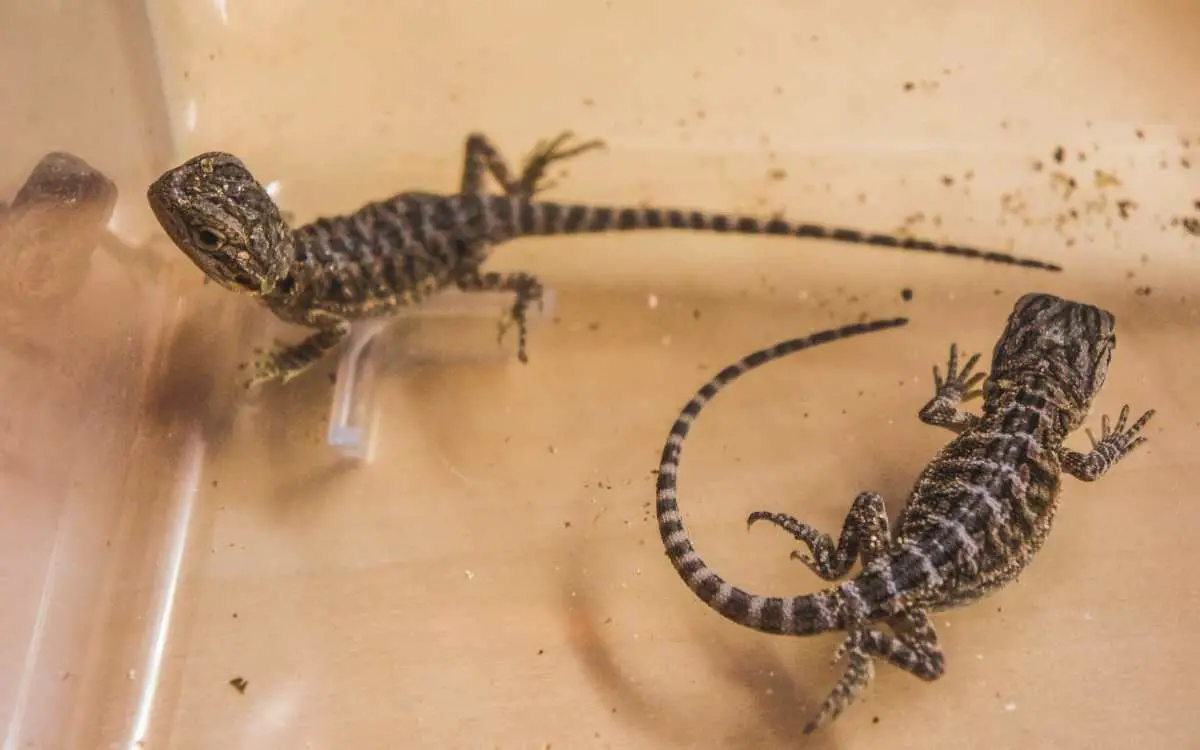
Your bearded dragons habitat isn’t the only thing you need to clean on a regular basis. A bath every week will keep your bearded dragon nice and clean, while also giving them time to swim and play in warm water.
A baby bearded dragon should be bathed in one of two places: a small plastic tub, or a kitchen/bathroom sink. Both spaces are quite small, and perfect for small bearded dragons.
A fully-grown bearded dragon should be bathed in a larger space, such as a regular-sized bathtub. Just know, though, that after you bathe your bearded dragon in this bathtub, you will need to thoroughly rinse the tub.
Make sure the water reaches your bearded dragon’s shoulders, and no higher than that. Too high, and your bearded dragon may have trouble moving around.
The temperature should be at least 85-degrees Fahrenheit. Make sure the water is warm, rather than hot.
Feel free to place a rock or branch in the water. Anytime your bearded dragon wants to get out of the water, they can do so by hopping onto that rock or branch.
The average length of a bearded dragon’s bath is around fifteen-minutes. That is more than enough time for your bearded dragon to get cleaned up, while also having some fun. If your bearded dragon looks uncomfortable or unhappy, though, then that’s a good sign that bath time is over.
Right after the bath, place your bearded dragon on a cloth towel and place it underneath the basking lamp in its habitat. Your bearded dragon will dry off, while underneath this basking lamp.
Bearded Dragon Teeth and Dental Care
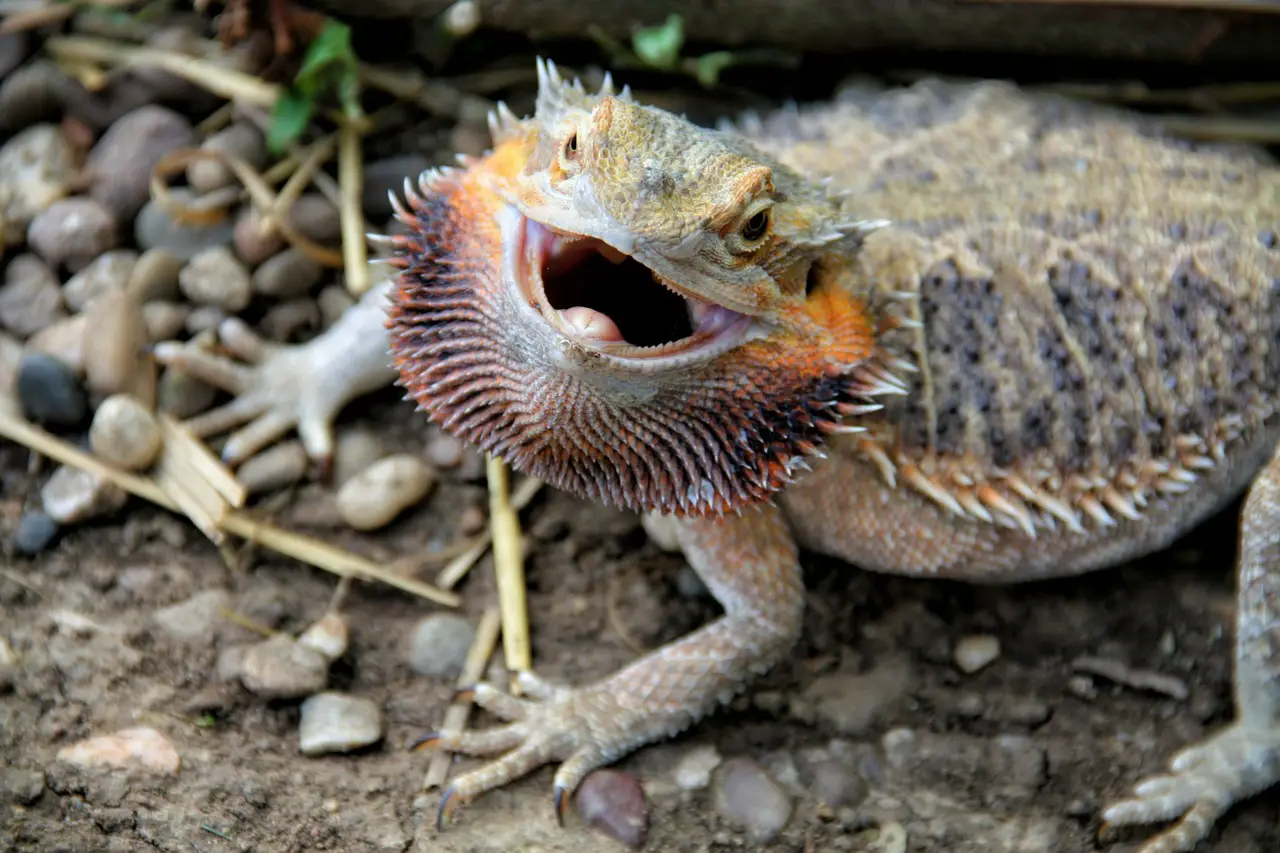
Just like us, bearded dragons are susceptible to periodontal disease. Most bearded dragons, despite never having their teeth brushed, will never suffer from periodontal disease. But, as a result of genetic and dietary factors that are still unclear, some bearded dragons are more susceptible to periodontal disease than others.
Even though periodontal disease is somewhat rare, brushing your bearded dragon’s teeth is never a bad idea. By brushing your bearded dragon’s teeth, you’ll be able to prevent periodontal disease, while also keeping your bearded dragon’s teeth free of plaque.
To brush your bearded dragon’s teeth, you will need to open up their mouth. Many bearded dragons, when they don’t know you too well, will be uncomfortable with you doing this. As a result, a strong connection with your bearded dragon makes the entire process significantly easier.
Assuming that you and your bearded dragon have a strong connection, the first thing you will need is a q-tip. Take a q-tip, and soak it in either dilute povidone-iodine solution or dilute chlorhexidine solution. After that, pick up your bearded dragon and hold its mouth open as you brush the q-tip along your bearded dragon’s teeth and gums.
Right after you do that, your bearded dragon will have nice, clean teeth. Brushing them regularly – twice-a-week is recommended – will prevent periodontal disease and keep your bearded dragon’s teeth nice and clean.
More: Read this article on my bearded dragon dental care routine to learn how to deadly avoid diseases such as gingivitis, mouth rot, and periodontal disease!
Shedding
Every bearded dragon sheds. However, young bearded dragons and adult bearded dragons both shed a little differently from one another.
A young bearded dragon – less than nine-months old – will shed every two-or-three-weeks. Most adult bearded dragons shed every few-months.
A young bearded dragon will shed much of its loose skin over the course of a short period of time. An adult bearded dragon will shed all of its loose skin in patches, often over the course of several days or even several weeks.
You can tell when your bearded dragon is about to shed by paying attention to two things: your bearded dragon’s skin, and their demeanor.
Right before shedding, your bearded dragons skin will become darker. Your bearded dragon will, in turn, become somewhat lazy and lethargic. Every now and then, your bearded dragons eyes may bulge.
None of those things should alarm you. All they are is signs that your bearded dragon is about to shed its old skin.
To make the shedding process easier for your bearded dragon, you can spray some water on their loose skin, or give them a warm bath. Both of these will loosen most of the loose skin, and make shedding much more pleasant for your bearded dragon.
Brumation
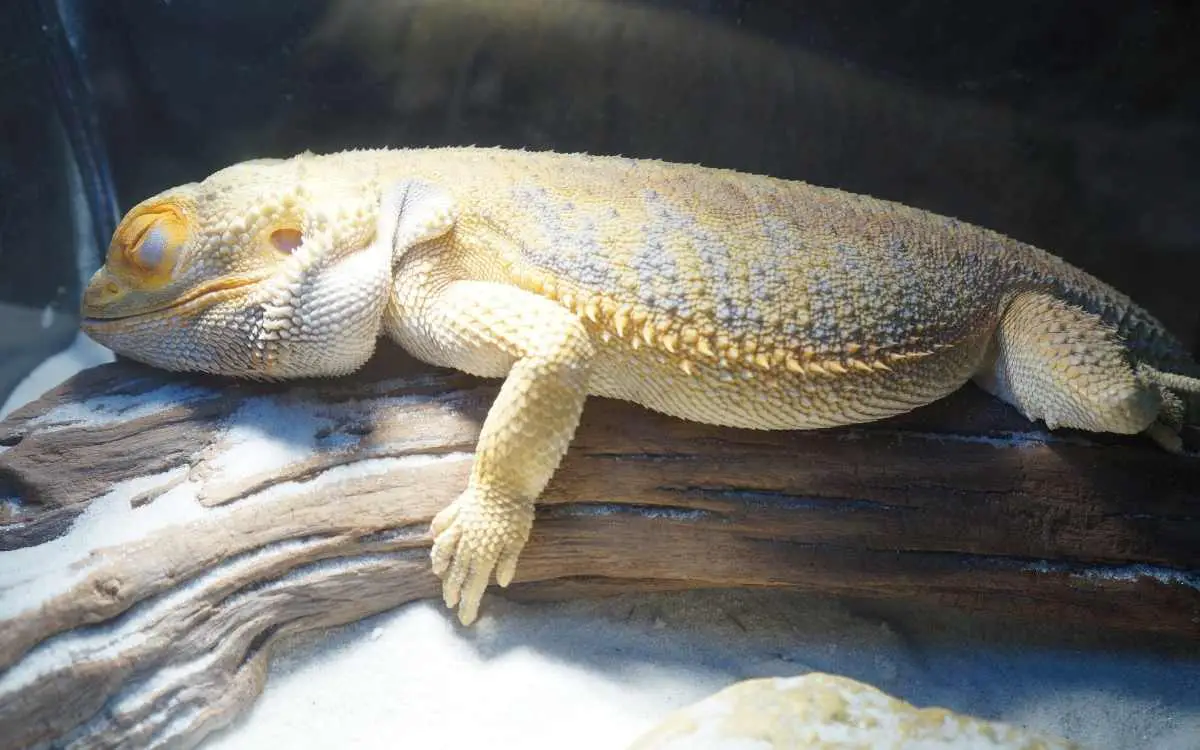
Every now and then, your bearded dragon may spend a period of several-days laying around and sleeping. This period is known as “brumation”.
Brumation is, essentially, the bearded dragon version of hibernation. A bearded dragon in brumation will rarely eat and drink very little water. Chances are, the only thing you will see your bearded dragon doing, during brumation, is sleeping.
Whenever your bearded dragon is brumating, there is nothing you need to do. Just let them brumate and, when they’re finished, make sure they have fresh food to eat and water to drink.
Signs Your Bearded Dragon May be Sick
Following the advice shared in this guide will keep your bearded dragon healthy and happy. Nevertheless, health issues can occur, even if you are taking all of the steps outlined in the guide.
Since health issues can occur, no matter what, you must be aware of, at the very least, the most common health issues. Being aware of these health issues will enable you to deal with them successfully, should you ever need to do so.
Diarrhea
A healthy bearded dragon – comfortable and with the right diet – will not experience diarrhea. A bearded dragon that is eating the wrong foods or feeling stressed and insecure will experience diarrhea.
To prevent your bearded dragon experiencing diarrhea, you must feed your bearded dragon the right foods, while also making their habitat as comfortable as possible. Make sure your bearded dragon is getting the foods they need, drinking enough water, and receiving enough light and heat.
Sometimes, even if all of those things are present, your bearded dragon will still experience diarrhea. More often than not, this is a result of dietary changes. Assuming these are positive changes, the diarrhea will pass.
Chronic diarrhea, however, is another problem entirely. Most of the time, chronic diarrhea is a result of parasites which can be removed with the help of a veterinarian.
Indigestion
Indigestion is a multi-faceted symptom that often leads to conditions such as obesity, a discolored stomach, bloody feces, a loss of appetite; among many others.
Just as with diarrhea, indigestion can be caused by parasites, foods your bearded dragon isn’t used to, stress, and an unhealthy diet. But, there’s one other major cause of indigestion, and that’s impaction.
Impaction is a condition that is often caused by your bearded dragon eating chunks of food that are too large or ingesting items that cannot be digested properly.
Anytime items of that sort are lodged in your bearded dragon’s digestive tract, your bearded dragon is unable to digest and excrete properly. Depending on what your bearded dragon has ingested, those items can push against the spinal column, leading to significant injury or death.
For most impaction cases, a nice, long belly-rub paired with a warm bath is all that’s needed. Sometimes, though, those items will remain stuck and, when that happens, you must take your bearded dragon to the vet.
Dehydration
Dehydration is the most common bearded dragon health symptom. Almost every bearded dragon will, at one point or another, suffer from dehydration.
The simplest way to notice this is by looking at your bearded dragon’s skin and eyes. Anytime the skin looks wrinkled and folded up, or the eyes look hollow and sunken, that’s a sign your bearded dragon is dehydrated.
To remedy dehydration, keep your bearded dragon’s water bowl full as often as possible. Spraying them down with water on a semi-frequent basis is also very helpful, especially if they aren’t drinking from their bowl as often as they should be.
What is the Lifespan of a Bearded Dragon?
The exact lifespan of a bearded dragon is entirely dependent on three factors: the bearded dragon’s health, the care that it is receiving, and the environment it lives in.
What is the Lifespan of a Wild Bearded Dragon?
A wild bearded dragon will, on average, live five-to-eight-years. The exact lifespan depends on the health of the bearded dragon, which is dependent on the environment the bearded dragon is living in and whether or not the bearded dragon is eating the right foods and drinking enough water. Genetic factors also play a role in determining lifespan but, due to living in the wild, health is often the most significant factor.
Lifespan of a Captive Bearded Dragon
A bearded dragon that you adopt will, if taken care of, live anywhere from eight-to-fourteen-years. Just as with every bearded dragon, the exact lifespan is heavily dependent on the care your bearded dragon is receiving and their health.
Most bearded dragons will, even when given the best care possible, live no more than twelve-years. Due to genetic factors, though, it isn’t too uncommon for some bearded dragons, when given the best possible care, to live up to fourteen-years.
A Longer Lifespan
Throughout the years, reports have been made regarding bearded dragons that have lived as long as nineteen-years. Some of these reports have been verified, but many of them have not.
Even though a longer lifespan – one as long as nineteen-years – is possible, it is unlikely. That said, depending on your bearded dragons genetics and the care it’s receiving, a longer lifespan is not impossible.
Conclusion
Raising and caring for a bearded dragon can be challenging. But, in the end, as long as you know what you need to do, and are prepared to have a lot of fun, the experience is never anything less than a treat.
